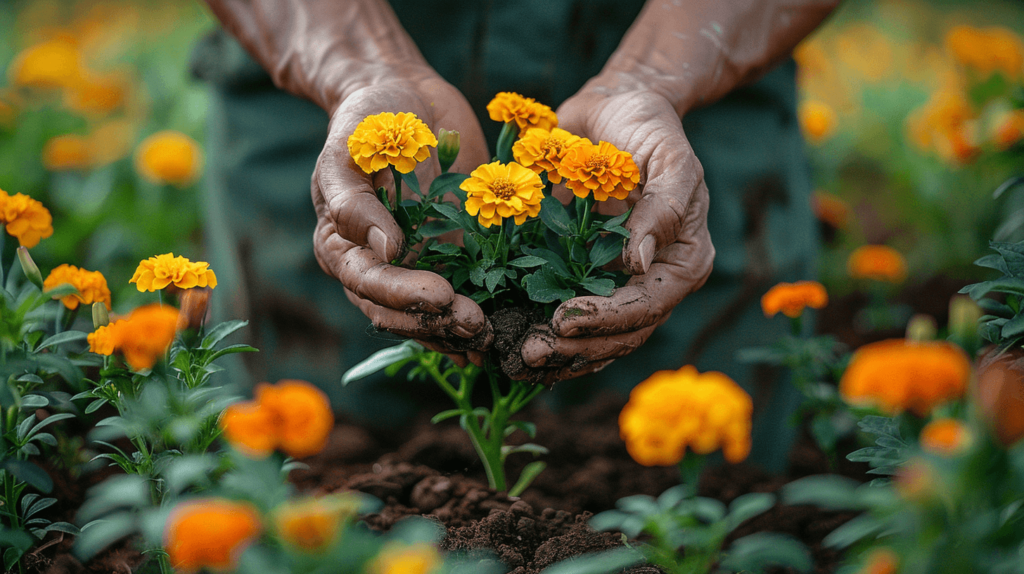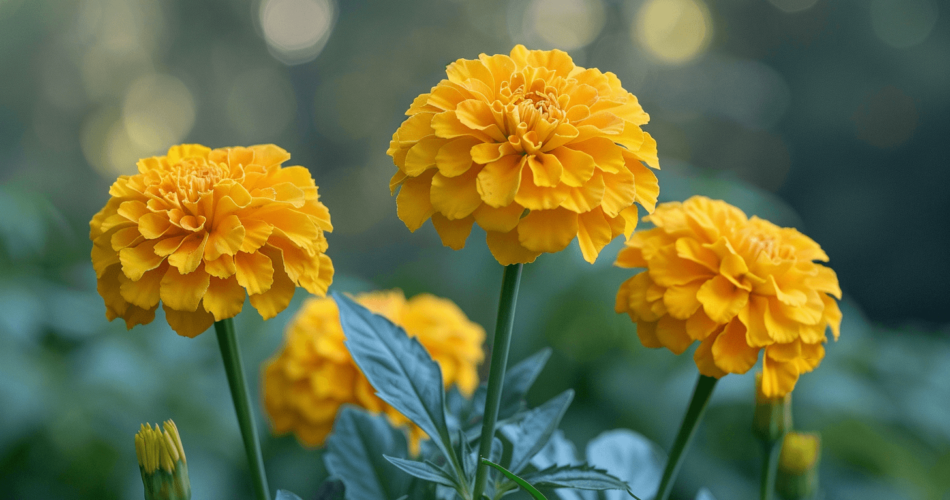Marigold flowers, also known as “Mary’s Gold,” have won the hearts of many around the world. They are loved for their bright colors and deep meaning. These flowers have a long history, starting with the ancient Aztecs and continuing through Hindu and Buddhist traditions today.
Related Post: Birth Flowers for all 12 months
Their colors, from deep yellow to vibrant orange, stand for power, strength, and enlightenment. People admire them not just for their looks but also for what they mean. They are often used in religious events and festivals like Dia de los Muertos and South Asian celebrations.

Key Takeaways
- Marigold flowers have deep cultural roots, ranging from Aztec to Hindu traditions.
- They symbolize power, strength, and enlightenment.
- Marigolds are deeply integrated into the celebrations of life and death across various cultures.
- With over 30 different species, these flowers offer a wide variety of colors and sizes.
- The natural properties of marigolds make them beneficial for eye health and useful in herbal products.
What is Marigold Flower?
Marigold flowers are bright and capture the spirit of autumn. They have a musky smell and colors that remind us of fall. These flowers are famous for their bright colors and are the October birth flower, marigold. They are loved in many cultures and have a long history.
The marigold flower meaning changes with each culture. They often stand for passion, creativity, and warmth. These flowers can grow from 6 inches to 3 feet tall. They are popular in gardens and have been mentioned in literature, like in Shakespeare’s works.
Marigolds come in many shapes and sizes. French marigolds have small flowers and grow up to 18 inches tall. African marigolds have bigger flowers and can grow up to 36 inches. There are many varieties, like the ‘Antigua™’ and ‘Durango®’ series, with colors like gold, orange, and red.
The october birth flower marigold is used in love rituals and medicine. Its bright yellow flowers have oils and resins that help with skin issues and as a natural dye. Marigold tea also helps with cramps and digestion, showing its many uses.
Marigolds are great for gardens, medicine, or as a symbol of October. They bloom a lot and need little care. This makes them a favorite among gardeners everywhere.
History and Origin of the Marigold Flower
The marigold is loved for its beauty and uses. It has a long history that spans many places and cultures.
The Ancient Aztec Connection
Marigolds come from Central America and were prized by the Aztecs. They valued these flowers for their looks and health benefits. The Aztecs used marigolds to treat hiccups and for protection.
Marigolds were also key in Aztec rituals. They used *Tagetes erecta*, or cempasuchil, in ceremonies to honor the goddess Mictecacihual. The Aztecs believed marigolds’ scent carried messages to their gods.
Journey to Europe
Marigolds soon caught the eye of European explorers in the 16th century. They were drawn to their bright colors and unique qualities. The flowers were first grown in Spain and then spread to France and Africa.
Marigolds thrived in different climates. French Marigolds (*Tagetes patula*) and African Marigolds (*Tagetes erecta*) became popular. French Marigolds have feathery leaves and bright flowers. African Marigolds have larger flowers and grow taller.
By the early 1600s, marigolds were a common sight in European gardens. They were easy to grow and bloomed often. In Britain, they were called “Rose-of-the-Indies” before being known as “Marigolds,” or “Mary’s Gold.”
Marigolds made their way to North America by the early 1800s. They were a favorite in American gardens. Today, marigolds are a big part of gardening, showing their rich history.
Physical Characteristics
Marigold flowers look like daisies or carnations. They can grow alone or in clusters. They love the sun and come in many colors like orange, yellow, red, and mahogany.
These flowers can be small or up to 3 feet tall. They attract good bugs like ladybugs and bees, which gardeners love.
Common Varieties
Marigolds come in two main types: French and African. French marigolds, like ‘Tangerine’, fight nematodes and grow up to 18 inches. African marigolds can grow taller and need support for their heavy flowers.
Both types like sun, heat, and dry soil. They’re good friends to veggies like tomatoes and cucumbers, making gardens beautiful and useful.
The Symbolism and Meaning of Marigold Flowers
The marigold flower is known for its bright colors and deep meaning. It has been a symbol of enlightenment and the sun’s power for centuries. This flower has been used in many ways, from ancient rituals to today’s celebrations.
Historical Symbolism
Marigold flowers have a long history in many cultures. Early Christians called them “Mary’s Gold” and used them instead of coins. Later, Victorians saw them as symbols of wealth, inspired by old stories.
In Hindu and Buddhist traditions, marigolds stand for power, strength, and light. They connect to the sun. The Aztecs also valued marigolds for their magical and spiritual qualities.
Marigolds also have a side that shows they can mean despaired love or rejection. Giving these flowers might warn of unfulfilled dreams. Around the world, they are seen as symbols of respect, spirituality, and caution.
Color Meanings
The colors of marigold flowers add to their meaning. Yellow marigolds are bright and uplifting, showing happiness and joy. They brighten any place.
Orange marigolds, with their warm tones, mean love, passion, and romance. They show strong feelings and are used to show deep love and passion. The colors of marigold flowers offer many meanings, celebrating their beauty and significance.
How to Grow Marigold Flowers
Marigolds are known for their bright colors and ability to thrive in tough conditions. They come in shades of yellow, orange, red, and white. These plants love full sun and can handle some drought, making them great for new gardeners.
Planting Tips
Marigolds grow easily from seeds. Pinching the tips helps them grow bushier. Here are some quick tips for planting:
- Plant marigold seeds in warm, well-drained soil in a sunny spot.
- For best results, sew the seeds directly outdoors after the last frost, as Tagetes marigolds are half-hardy annuals that won’t tolerate frost.
- Ensure the soil is reasonably fertile but not overly rich to prevent excessive leafy growth instead of blooms.
- Once planted, marigolds typically sprout within a week in warm weather and produce blooms in about 8 weeks.
- Spacing is crucial: French and signet marigolds should be 8 to 10 inches apart, while larger African marigolds should be at least 10 to 12 inches apart.
Maintenance and Care
Proper care ensures marigolds bloom all summer and into autumn. Follow these tips:
- Water marigolds wisely to prevent mildew, focusing on watering from the plant’s base.
- Regularly deadhead spent blooms to encourage new blooms, enhancing the overall beauty of your marigold flower garden.
- When bringing marigolds indoors, strip off foliage to minimize the strong musky odor.
- For potted marigolds, water regularly and apply liquid fertilizer every 7-14 days from midsummer onwards.
- Ensure your marigolds are in a sheltered site, as they do best in such conditions.
- Marigolds can be used as companion plants to deter pests like whitefly, leveraging marigold flower uses beyond mere aesthetic appeal.
| Variety | Height | Flower Size |
|---|---|---|
| Tagetes erecta (African Marigolds) | 3 to 4 feet | Up to 10cm across |
| Tagetes patula (French Marigolds) | 6 inches to 2 feet | Up to 5cm across |
| Tagetes tenuifolia (Signet Marigolds) | Up to 45cm high | Small single blooms |
With these tips, you’ll grow vibrant and healthy marigolds. They add beauty and practical uses to your garden.
Types of Marigold Flowers
Marigolds are some of the most colorful and versatile flowers out there. They come in many types, each with its own unique look. Knowing the different types of marigold flower is key for gardeners wanting to brighten up their space.
There are five main types of marigold flowers:
- African Marigolds: Also known as Tagetes erecta, these marigolds can grow up to four feet tall. They have double flowers up to five inches in diameter. They’re perfect for making a bold statement in larger gardens.
- French Marigolds: Known scientifically as Tagetes patula, these plants are compact, reaching six to twelve inches tall. They have smaller, complex flowers and are great for borders and containers.
- Triploid F1 Hybrid Marigolds: These hybrids can’t set seeds but bloom a lot throughout the season. They combine the best of African and French marigolds.
- Mexican Tarragon: Scientifically named Tagetes lucida, this type has cheerful yellow flowers and aromatic leaves. It’s good for both decoration and cooking.
- Signet Marigolds: Known as Tagetes tenuifolia, these are the smallest, usually around six inches tall. Their edible flowers are great in salads, and their leaves repel pests.

- Alumia Vanilla Cream, Antigua Orange, Autumn Orange
- Crackerjack, Cresta Orange, Dainty Marietta
- Diamond Jubilee Orange, Diamond Jubilee Yellow, Janie Spry
- Lemon Gem, Mexican Tarragon, Red Gem
- Red Marietta, Safari Gold, Spanish Brocade
The Marigold BigTop® Yellow was a 2020 Top Ten Performing Annual in the University of Minnesota WCROC annual flower trial. The Marigold Big Duck Orange was recognized in 2019.
Marigold seeds germinate in five to eight days at 70-75°F. They grow best in full sun and well-draining soil. Deadheading them encourages more blooms. They prefer soil pH between 6 and 7, making them easy to grow in many soils. Plus, they naturally repel pests, making them great companions.
The Cultural Significance of Marigolds
Marigolds are loved in many cultures for their bright colors and many uses. They are known as Calendula officinalis and stand for purity, abundance, and spirituality. This makes them key in many religious and cultural events. They also play a big role in cooking, medicine, and gardening.
Religious Ceremonies
In Hindu and Mexican traditions, marigolds are very important. In India, they are used in weddings and festivals. Their colors are seen as lucky and bring blessings.
In Mexico, marigolds are used to honor the dead during the Day of the Dead. People believe the flowers guide spirits back home with their scent.
Modern Uses
Marigolds are used in many ways today. Gardeners like them because they keep pests away and are easy to grow. French marigolds fight nematodes, while Mexican marigolds keep insects and rabbits out.
They are also used in making natural dyes and adding color and taste to food. Marigold extracts help with skin problems and are used in skincare.
In the U.S., marigolds symbolize warmth and creativity. They are seen as positive.
| Region | Significance | Uses |
|---|---|---|
| India | Religious ceremonies and festivals | Weddings, festivals, garlands |
| Mexico | Day of the Dead celebrations | Guiding spirits, honoring the deceased |
| United States | Warmth and creativity | Gardening, decoration |
Marigolds are special because they mix cultural value with everyday uses. They are loved in old traditions and new ways of life.
Marigold Flower Colors and Their Meanings
The marigold flower colors show a rich tapestry of meanings in many cultures. The colors, from bright yellows to vibrant orange-reds, carry deep emotional messages and connections.
Yellow marigolds are all about joy, happiness, and positivity. Their bright look instantly makes us feel better and brings warmth and cheer.
Orange marigolds stand for enthusiasm, boldness, and energy. The deep orange color shows strong feelings and a love for life. It’s also a sign of bravery and being different.
Red and maroon marigolds represent romantic passion, desire, and deep love. They are symbols of love and show strong, lasting relationships.
Marigolds are not just beautiful; they also carry deep cultural and symbolic meanings:
- In Mexican culture, marigolds are key in Dia de los Muertos. They remember and guide spirits back to the living.
- In India, marigolds are important in religious events, weddings, and festivals. They symbolize good luck and spiritual protection.
- In Victorian symbolism, marigolds showed feelings like grief and protection against evil.
The variety of marigold flower colors shows their flexibility. They are not just for gardens but also for expressing deep feelings. This makes them a favorite flower worldwide.
Marigold Flowers in Literature and Art
The marigold flower has a long history in literature and art. It has been loved by many cultures and times. Shakespeare mentioned it six times in his works, showing its beauty and meaning.
In the Victorian era, marigolds were seen as symbols of grief and mourning. Young women used to interpret flowers’ meanings, adding depth to their culture. Despite being seen as unlucky in games, marigolds were celebrated in other ways.

Artist Walter Crane’s Flowers from Shakespeare’s Garden showed marigolds in a positive light. This work highlighted the marigold’s changing role in art and literature over time.
English soldiers in the twentieth century used marigold oil for medicine. Today, marigold drawings and paintings are still loved for their bright colors. This shows the marigold’s lasting charm and its big impact on art.
Benefits of Marigold Flowers
Marigold flowers, especially the pot marigold, or Calendula officinalis, are loved for their beauty and uses. They are not just pretty; they also have many benefits for gardens and health.
Pest Repellent Properties
One big benefit of marigold flower is that they keep pests away. This makes them great friends for vegetable gardens. Their strong smell keeps nematodes and insects from harming plants.
Marigolds are known to keep aphids away from beans, potatoes, broccoli, and leafy greens. This helps protect the crops and makes the garden healthier and more productive.
Medicinal Uses
Calendula officinalis, a type of marigold, has been used for healing for centuries. It’s known for its ability to treat many health issues. Studies show that it helps wounds heal by reducing swelling and pain.
A study with 21 adults showed that marigold cream improved their skin health. Women with cesarean scars healed faster and had less swelling and redness with calendula treatments. Marigold flowers are also good for treating bacterial vaginosis, just like standard drugs but without side effects.
Marigold flowers can also soothe burns, rashes, and minor wounds. They have been used as antiseptics in wars, showing their value in natural remedies. Pot marigold is full of antioxidants that protect and repair the skin.
Marigold tea is also good for detoxifying and soothing the intestines. It acts as an anti-fungal agent. Marigolds are important for natural and holistic health, making them a valuable medicinal plant.
- Promotes wound healing
- Anti-inflammatory benefits
- Anti-bacterial, antifungal, and immune-boosting properties
- Detoxifying benefits
In summary, marigold flowers are very useful in gardening and for health. They are essential for natural and sustainable living.
Caring for Marigold Flowers Indoors
Starting to care for marigold flowers indoors is all about preparation. We’ll explore the key steps to make sure they thrive in your home.
Cutting and Preparing Stems
To keep your marigold flowers fresh, cut them at the right time. Here’s how to cut and prepare them:
- Trimming at an Angle: Cut stems at a 45-degree angle to help them absorb water better.
- Removing Excess Foliage: Take off leaves below the water line to prevent bad smells and keep them fresh longer.
- Hydrating: Put the cut stems in water right away to stop air from getting in.
Watering and Preservation
Effective care for marigold flowers indoors includes regular watering and preservation. Here are some tips to keep them looking great:
- Water them regularly to avoid wilting, keeping the soil moist but not too wet.
- Change the water in vases often to fight off bacteria.
- Use a plant preservative solution to make the flowers last longer.
- Keep marigolds away from too much heat or drafts to keep them healthy.
Following these tips will help you make the most of marigold flowers in your home. You’ll create a beautiful and healthy space.
Fun Facts About Marigold Flowers
Marigolds are fascinating plants with rich histories and remarkable versatility. Here are some captivating marigold flower facts:
- Marigolds belong to the Tagetes genus and are native to North and South America, boasting around 50 species.
- These vibrant blooms are cultivated primarily for their stunning colors, edible petals, and pest-repellent properties.
- They contain high levels of carotenoids such as lutein and zeaxanthin, beneficial for eye health and often used in food coloring.
- Their strong, pungent odor naturally repels pests like aphids, mosquitoes, and nematodes, making them valuable companion plants.
- Historically, marigold roots are used to deter nematodes when planted around tomatoes and potatoes.
- Marigold petals are culturally significant, especially during Mexican Dia de los Muertos celebrations where they guide spirits back to the living world.
- Components from marigold flowers are utilized in skincare products due to their soothing and moisturizing properties.
- These flowers attract pollinators such as bees, butterflies, moths, and hummingbirds, especially single-flower types.
- Marigold tea, made from the petals, offers various health benefits, including soothing digestive issues and reducing inflammation.
- Marigolds have been cultivated for over 2,000 years, underscoring their enduring popularity and significance across various cultures.
Let’s take a closer look at some marigold flower facts:
| Fact | Details |
|---|---|
| Species | 50 species across North, Central, and South America |
| Cultural Significance | Used in Día de los Muertos celebrations and Hindu religious rituals |
| Health Benefits | Rich in antioxidants lutein and zeaxanthin, beneficial for eye health |
| Pest Control | Repels aphids, mosquitoes, nematodes |
| Culinary Uses | Edible petals used in salads, soups, and desserts |
| Pollinators | Attracts bees, butterflies, moths, hummingbirds |
| Historical Cultivation | Over 2,000 years of cultivation |
These remarkable marigold flower facts showcase their enduring appeal and numerous benefits. They make a delightful addition to any garden or celebration.
Conclusion
Our journey into marigold flowers has shown their deep history, cultural ties, and many uses. They have been important in Aztec lore and European gardens. Marigold flower colors are not just pretty; they also mean joy, celebration, and new starts.
Marigolds are also useful. They keep pests away and help with skin problems. In cooking, their petals add a unique taste to many foods. Their bright colors also show they are full of antioxidants, which are good for our health.
Marigolds hold special meaning in Mexico’s Dia de los Muertos, symbolizing remembrance. They have inspired artists and writers with their beauty. In short, marigolds are more than just flowers; they show nature’s beauty, usefulness, and lasting impact.
FAQ
What is a marigold flower?
The marigold flower is also called “Mary’s Gold.” It’s a bright flower linked to the sun’s power. It comes in colors like yellow, orange, and red, looking like daisies or carnations.
What is the meaning of marigold flowers?
Marigold flowers mean many things. They stand for power, strength, and enlightenment. They also show creativity, passion, and sorrow for lost love. Different colors have different meanings, like joy in yellow and romance in orange-red.
How do you care for marigold flowers?
Marigold flowers are easy to grow. They love full sun and can handle some drought. Plant seeds in warm soil and pinch stems for bushy growth. Water from the bottom to avoid mildew. Keep them looking good by deadheading and watching for pests.
What are the different types of marigold flowers?
There are 56 types of marigold flowers. You’ll find French, African, and signet marigolds. Each type is different in size, shape, color, and how they grow. Some like dry soil, while others prefer it moist.
What is the historical significance of marigold flowers?
Marigold flowers have a long history. The Aztecs grew them for health and in religious rituals. They came to Europe with Spanish explorers and later to North America. They’re loved for their beauty and ability to thrive in gardens.
How do marigold flowers play a role in religious and cultural ceremonies?
Marigold flowers are key in many ceremonies. They’re used in Hindu harvest festivals and the Latin American Day of the Dead. Their bright colors are believed to guide souls to the afterlife.
What are the benefits of marigold flowers?
Marigold flowers are great for gardens because they repel pests. They’re also good for the skin and can help with inflammation. This makes them useful in natural remedies and holistic health.
How do you grow marigold flowers?
Growing marigold flowers is simple. Plant seeds in warm soil and make sure they get full sun. Water them regularly but avoid overhead watering. Deadheading spent flowers will keep them blooming. Marigolds are tough and can grow well in many conditions.
What are some fun facts about marigold flowers?
Marigolds are interesting because they grow well in many places. They’re strong against pests and were sacred to the Aztecs. They’ve even been mentioned in Shakespeare’s works.
What colors do marigold flowers come in, and what do they signify?
Marigold flowers come in many colors, each with its own meaning. Yellow marigolds mean joy and positivity. Orange-red marigolds show love and passion. Pure orange marigolds bring strong emotions and positive vibes.
How do you care for marigold flowers indoors?
To care for marigold flowers indoors, cut the stems when they’re in bloom. Remove leaves to cut down on smell. Place them in water with preservatives. Keep them away from too much heat or drafts. Make sure they have consistent water and check on them often to keep them fresh.
Source Links
- https://www.vedantu.com/evs/facts-about-marigold-flower – Facts About Marigold Flower |Learn Important Terms and Concepts
- https://www.careofchan.com/articles/marigold-traditions-uses – Marigold Traditions in Mexico and India
- https://hgic.clemson.edu/factsheet/marigold/ – Marigold
- https://www.britannica.com/video/180200/Overview-marigolds – Marigold | A Multipurpose Plant
- https://plants.ces.ncsu.edu/plants/tagetes/ – Tagetes (Marigold) | North Carolina Extension Gardener Plant Toolbox
- https://www.harvesting-history.com/marigolds/ – Marigolds
- https://www.blueridgebotanic.com/blog/marigolds-a-sunny-little-flower-with-a-rich-amp-colorful-history – Marigolds: A Sunny Little Flower with a Rich & Colorful History — Blue Ridge Botanic
- https://piedmontmastergardeners.org/article/marigold-more-than-a-pretty-face/ – Marigold: More Than a Pretty Face
- https://www.gardeningknowhow.com/ornamental/flowers/marigold/marigold-flower-uses.htm – Marigold Flower Uses: Marigold Benefits For Gardens And Beyond
- https://www.bootstrapfarmer.com/blogs/growing-flowers/marigold-cultivation-for-flower-farmers – Marigold Cultivation for Flower Farmers – Bootstrap Farmer
- https://thursd.com/articles/marigold-flowers-meanings – Marigold Flowers – A Touch of Tradition
- https://cabo.villadelpalmar.com/blog/lifestyle/the-vibrant-marigold-flower-a-symbol-of-life-and-death-in-day-of-the-dead-traditions – Marigold Flower: A Symbol of Life and Death
- https://www.lovingly.com/flower-meanings/marigolds – Marigolds – Flowers – Featured Content – Lovingly
- https://www.gardenersworld.com/how-to/grow-plants/how-to-grow-marigolds/ – How to grow marigolds
- https://www.almanac.com/plant/marigolds – How to Grow Marigolds: The Complete Marigold Flower Guide
- https://extension.umn.edu/flowers/marigolds – Marigolds
- https://www.thespruce.com/types-of-marigolds-7964249 – Marigolds Are the Perfect Companion Plants—Here Are 20 Varieties to Try
- https://www.lovenspire.com/blogs/lovenspire-blog-corner/the-vibrant-marigold-a-global-symbol-of-culture-and-importance – The Vibrant Marigold: A Global Symbol of Culture and Importance
- https://www.floraqueen.com/blog/why-marigold-is-a-staple-in-many-cultures– Why Marigold Is a Staple in Many Cultures
- http://heritagegarden.uic.edu/marigold-tagetes – Marigold (Tagetes) — UIC Heritage Garden
- https://simplybeyondherbs.com/marigold-flower-meaning/ – Marigold Flower Meaning and Symbolism.
- https://kathleenkarlsen.com/marigold-meaning/ – Marigold Meaning and Symbolism
- https://verderamade.com/2021/10/29/marigold-flower-meaning/ – Marigold Flower Meaning – Flower Sketches – Lynchburg Marketing Agency – Danielle Verderame
- https://www.shakespeare.org.uk/explore-shakespeare/blogs/marigold-on-death-beds-blowing-the-marigold-in-shakespeare-and-victorian-england/ – Shakespeare’s Favourite Flowers: The Marigold
- https://udayton.edu/imri/mary/m/marigolds-marys-gold.php – Marigolds: Mary’s Gold : University of Dayton, Ohio
- https://www.webmd.com/vitamins-and-supplements/what-health-benefits-marigold-extract-calendula – What Are the Health Benefits of Marigold Extract (Calendula)?
- https://www.planetnatural.com/benefits-of-marigolds/ – Beyond Beauty: Unveiling 11 Marvels of Marigolds
- https://www.indigo-herbs.co.uk/natural-health-guide/benefits/marigold – Marigold Benefits
- https://www.geturbanleaf.com/blogs/edible-flowers/growing-marigold-indoors – How to Grow Marigold Indoors
- https://www.houseplantaddicts.com/how-to-grow-marigolds-as-houseplants/ – How To Grow Marigolds As Houseplants
- https://www.bhg.com/facts-about-marigolds-8383915 – 5 Facts About Marigolds You Probably Didn’t Know
- https://urbanwhip.com/blogs/news/marigold-fun-facts – mARIGOLD | fUN fACTS
- https://facts.net/lifestyle/food/14-facts-about-marigold/ – 14 Facts About Marigold
- https://lovflowers.co.uk/blogs/news/marigolds – Marigolds: From Gardens to Crafts and Culinary Delights
- https://www.ncbi.nlm.nih.gov/pmc/articles/PMC8980490/ – Green extraction of lutein from marigold flower petals, process optimization and its potential to improve the oxidative stability of sunflower oil
- https://en.wikipedia.org/wiki/Tagetes – Tagetes

